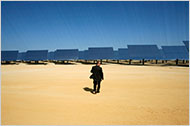There’s a lot in these articles, and a lot to read between the lines in these articles from the New York Times
– Business Section. (Between the Lines Concept 1
– the Business Section, not the Science
section.)
From E.U. Plan to Curb Carbon Dioxide Would Favor Solar Power
 “The European Commission is expected to introduce a plan to reduce greenhouse gas emissions that directs the largest slices of €50 billion available for research and development to solar power and capturing and burying emissions from coal plants.”
“The European Commission is expected to introduce a plan to reduce greenhouse gas emissions that directs the largest slices of €50 billion available for research and development to solar power and capturing and burying emissions from coal plants.”
“But the plan also signals the need for a reordering of the bloc’s priorities by requiring governments to spend significantly greater sums of money on clean energy even as the world emerges from a deep financial crisis.”
- 16 Billion Euros for Solar.
- 13 Billion Euros for emissions capture and storage.
- 11 billion Euros for enhanced urban efficiency.
- 7 billion Euros for improving nuclear energy – produce less radioactive waste, minimize proliferation.
Between The Lines Concept 2: Euros 13 Billion for Emissions Capture and Storage – that’s a lot of money. Assuming they can make it work – Carbon Capture and Storage has never been done, and other coal waste storage is expensive and difficult. Kingston, Tennessee Coal Ash Spill – Nasa / National Geographic / Popular Logistics 1 / Popular Logistics 2
From “Regulators Plan to Study Health Risks of Atrazine,” by Charles Duhigg
“The EPA plans to conduct a new study about the potential health risks of atrazine, a widely used weedkiller that may be more dangerous to humans than previously thought. Atrazine – used on corn fields, golf courses and even lawns – has become one of the most common contaminents in American drinking water. . . . Atrazine in drinking water is associated with birth defects, low birth weight and reproductive problems in humans.”
From “Greenhouse Emissions Expected to Decline in Wake of Recession“
“Report Credits China For Easing Pollution” By Jad Mouawad, pg B5
Little good can be said about the worst economic slump since the 1930s, but it has produced at least one piece of positive news: the downturn will make it a bit easier to slow the rise in emissions responsible for climate change.
The International Energy Agency made that prediction in a report Tuesday on global greenhouse gas emissions. Because of slower economic growth, the agency slashed, by 5 percent, its estimate of how much greenhouse gas emissions will be produced in 2020.
But the energy agency also cautioned against complacency, stressing that reaching a deal in climate talks to be held in Copenhagen at the end of the year is crucial to limiting the rise in global temperatures.